Effects of Severe Plastic Deformation and Subsequent Annealing on Microstructures of a Ni50.6Ti49.4 Shape Memory Alloy
Abstract
1. Introduction
2. Experimental Material and Procedures
3. Results
3.1. Microstructure Characterization
3.2. Microhardness Evolution
3.3. Microstructure after Post-HPT Annealing
3.4. Phase Transformation Behavior
4. Discussions
4.1. Microstructural Evolution during HPT Processing
4.2. Microstructural Evolution after Post-Deformation Annealing
4.3. Transformation Behavior
5. Conclusions
- During HPT processing of Ni50.6Ti49.4 (at.%) alloy, stress-induced phase transformation and amorphization occurred. As the HPT turns increased, the fraction of the amorphous phase increased with a non-linear style. In the early stage of HPT, the rate of amorphization was quite fast, whereas it became moderate after 2 turns.
- The microhardness was 290 HV in the as-received status. After 1/4-turn HPT, the average microhardness increased to 355 HV, and it increased to 398 HV when the HPT turns were 16. The increment of microhardness is due to the contributions from the strain-induced martensite transformation, the formation of the amorphous phase, increased dislocations and grain refinement.
- After the HPT-processed 16-turns sample was annealed at 450 °C for 2 h, nano-scale grains were formed. DSC results revealed that SMA effect was exhibited in the post-HPT-annealed 16-turns sample. The results in the present work indicate that NiTi SMA can be produced directly from ingot by HPT and post-HPT annealing, which is a feasible processing route. The future direction is to achieve refined and homogeneous microstructure in NiTi ingots through HPT so that better mechanical properties can be achieved.
Author Contributions
Funding
Data Availability Statement
Conflicts of Interest
References
- Jani, J.M.; Leary, M.; Subic, A.; Gibson, M.A. A review of shape memory alloy research, applications and opportunities. Mater. Des. 2014, 56, 1078–1113. [Google Scholar] [CrossRef]
- Yan, B.; Zhang, Y.Q.; Jiang, S.Y.; Yu, J.B.; Sun, D.; Tang, M. Mechanical properties and fracture mechanisms of martensitic NiTi shape memory alloy based on various thermomechanical-processing microstructures. J. Alloys Compd. 2021, 883, 160797. [Google Scholar] [CrossRef]
- Sun, D.; Jiang, S.Y.; Zhang, Y.Q.; Yan, B.Y.; Yu, J.B. Influence of annealing on incomplete detwinning and deformation twinning in equiatomic NiTi shape memory alloy undergoing severe plastic deformation. J. Alloys Compd. 2021, 871, 159550. [Google Scholar] [CrossRef]
- Tadayyon, G.; Guo, Y.; Mazinani, M.; Zebarjad, S.M.; Tierman, P.; Tofail, S.A.M.; Biggs, J.P. Effect of different stages of deformation on the microstructure evolution of Ti-rich NiTi shape memory alloy. Mater. Charac. 2017, 125, 51–66. [Google Scholar] [CrossRef]
- Chen, H.; Xiao, F.; Liang, X.; Li, Z.X.; Li, Z.; Jin, X.J.; Min, N.; Fukuda, T. Improvement of the stability of seperelasticity and elastocaloric effect of a Ni-rich Ti-Ni alloy by precipitation and grain refinement. Sci. Mater. 2019, 162, 230–234. [Google Scholar]
- Zhang, J.T.; Wang, S.B.; Hu, P.; Zhang, Y.; Ding, H.; Huang, Y. A novel strategy for fabricating phase transforming NiTi shape memory alloy via multiple processes of severe plastic deformation. Mater. Lett. 2024, 15, 135439. [Google Scholar] [CrossRef]
- Wang, Z.F.; Chen, J.W.; Kocich, R.; Tardif, S.; Dolbnya, I.P.; Kunčická, L.; Micha, J.S.; Liogas, K.; Magdysyuk, O.V.; Szurman, I.; et al. Grain structure engineering of NiTi shape memory alloys by intensive plastic deformation. ACS Appl. Mater. Interfaces 2022, 14, 31396–31410. [Google Scholar] [CrossRef]
- Kreitcberg, A.; Brailovski, V.; Prokoshkin, S.; Gunderov, D.; Khomutov, M.; Inaekyan, K. Effect of the grain/subgrain size on the strain-rate sensitivity and deformability of Ti-50 at% Ni alloy. Mater. Sci. Eng. A 2015, 622, 21–29. [Google Scholar] [CrossRef]
- Yan, B.Y.; Jiang, S.Y.; Sun, D.; Wang, M.; Yu, J.B.; Zhang, Y.Q. Martensite twin formation and mechanical properties of B2 austenite NiTi shape memory alloy undergoing severe plastic deformation and subsequent annealing. Mater. Charac. 2021, 178, 111273. [Google Scholar] [CrossRef]
- Jiang, S.Y.; Tang, M.; Zhao, Y.N.; Hu, L.; Zhang, Y.Q.; Liang, Y.L. Crystallization of amorphous NiTi shape memory alloy fabricated by severe plastic deformation. Trans. Nonferrous Met. Soc. China 2014, 24, 1578–1765. [Google Scholar] [CrossRef]
- Hua, P.; Wang, B.; Yu, C.; Han, Y.L.; Sun, Q.P. Shear-induced amorphization in nanocrystalline NiTi micropillars under large plastic deformation. Acta Mater. 2022, 241, 118358. [Google Scholar] [CrossRef]
- Shahmir, H.; Nili-Ahmadabadi, M.; Huang, Y.; Jung, J.M.; Kim, H.S.; Langdon, T.G. Shape memory effect in nanocrystalline NiTi alloy processed by high-pressure torsion. Mater. Sci. Eng. A 2015, 626, 203–206. [Google Scholar] [CrossRef]
- Pushin, V.G.; Valiev, R.Z.; Valiev, E.Z.; Kourov, N.I.; Kuranova, N.N.; Makarov, V.V.; Pushin, A.V.; Uksusnikov, A.N. Phase and structural transformation in the Ti49.5Ni50.5 alloy with a shape-memory effect during torsion under high pressure. Phy. Met. Metallogr. 2012, 113, 256–270. [Google Scholar] [CrossRef]
- Prokoshkin, S.D.; Khmelevskaya, I.Y.; Dobatkin, S.V.; Trubitsyna, I.B.; Tatyanin, E.V.; Stolyarov, V.V.; Prokofiev, E.A. Alloy composition, deformation temperature, pressure and post-deformation annealing effects in severely deformed Ti–Ni based shape memory alloys. Acta Mater. 2005, 53, 2703–2714. [Google Scholar] [CrossRef]
- Huang, J.Y.; Zhu, Y.T.; Liao, X.Z.; Valiev, R.Z. Amorphization of TiNi induced by high-pressure torsion. Phil. Mag. Lett. 2004, 84, 183–190. [Google Scholar] [CrossRef]
- Valiev, R.Z.; Gunderov, D.V.; Lukyanov, A.V.; Pushin, V.G. Mechanical behavior of nanocrystalline TiNi alloy produced by severe plastic deformation. J. Mater. Sci. 2012, 47, 7848–7853. [Google Scholar] [CrossRef]
- Sergueeva, A.V.; Song, C.; Valiev, R.Z.; Mukherjee, A.K. Structure and properties of amorphous and nanocrystalline NiTi prepared by severe plastic deformation and annealing. Mater. Sci. Eng. A 2003, 339, 159–165. [Google Scholar] [CrossRef]
- Gunderov, D.; Lukyanov, A.; Prokofiev, E.; Kilmametov, A.; Pushin, V.; Valiev, R. Mechanical properties and martensitic transformation in nanocrystalline Ti49.4Ni50.6 alloy produced by high-pressure torsion. Mater. Sci. Eng. A 2009, 503, 75–77. [Google Scholar] [CrossRef]
- Khmelevskaya, I.Y.; Prokoshkin, S.D.; Dobatkin, S.V.; Tatynin, E.V.; Trubitsyna, I.B. Studies of composition, deformation temperature and pressure effects on structure formation in severely deformed TiNi-based alloys. Mater. Sci. Eng. A 2006, 438–440, 472–475. [Google Scholar] [CrossRef]
- Ewert, J.C.; Böhm, I.; Peter, R.; Haider, F. The role of the martensite transformation for the mechanical amorphisation of NiTi. Acta Mater. 1997, 45, 2197–2206. [Google Scholar] [CrossRef]
- Zhilyaev, A.P.; Langdon, T.G. Using high-pressure torsion for metal processing: Fundamentals and applications. Progress Mater. Sci. 2008, 53, 893–979. [Google Scholar] [CrossRef]
- Shuro, I.; Umemoto, M.; Todaka, Y.; Yokoyama, S. Phase Transformation and Annealing Behavior of SUS 304 Austenitic Stainless Steel Deformed by High Pressure Torsion. Mater. Sci. Forum. 2010, 654, 334–337. [Google Scholar]
- Nakayama, H.; Tsuchiya, K.; Liu, Z.G.; Umemoto, M.; Morii, K.; Shimizu, T. Process of nanocrystallization and partial amorphization by cold rolling in TiNi. Mater. Trans. 2001, 42, 1987–1993. [Google Scholar] [CrossRef]
- Razumov, I.K.; Yermalkov, A.Y.; Gormostyrev, Y.N.; Straumal, B.B. Nonequelibrium phase transformations in alloys under severe plastic deformation. Physics-Uspekhi 2020, 63, 733–757. [Google Scholar] [CrossRef]
- Straumal, B.; Korneva, A.; Zieba, P. Phase transitions in metallic alloys driven by the high pressure torsion. Arch. Civ. Mech. Eng. 2014, 14, 242–249. [Google Scholar] [CrossRef]
- Wang, X.B.; Verlinden, B.; Van Humbeeck, J. R-phase transformation in NiTi alloys. Mater. Sci. Technol. 2014, 30, 1517–1529. [Google Scholar] [CrossRef]
- Waitz, T.; Karnthaler, H.P. Martensitic transformation of NiTi nanocrystals embedded in an amorphous matrix. Acta Mater. 2004, 52, 5461–5469. [Google Scholar] [CrossRef]
- Waitz, T.; Antretter, T.; Fischer, F.D.; Simha, N.K.; Karnthaler, H.P. Size effects on the martensitic phase transformation of NiTi nanograins. J. Mech. Phys. Solids 2007, 55, 419–444. [Google Scholar] [CrossRef]
- Waitz, T.; Antretter, T.; Fischer, F.D.; Karnthaler, H.P. Size effects on the martensitic phase transformation in nanocrystalline NiTi shape memory alloys. Mater. Sci. Technol. 2008, 24, 934–940. [Google Scholar] [CrossRef]
- Shi, X.B.; Ma, Z.Y.; Zhang, J.S.; Ding, H.L.; Guo, F.M.; Liu, Y.; Cui, L.S. Grain size effect on the martensitic transformation temperatures of nanocrystalline NiTi alloy. Smart Mater. Struct. 2015, 24, 072001. [Google Scholar] [CrossRef]
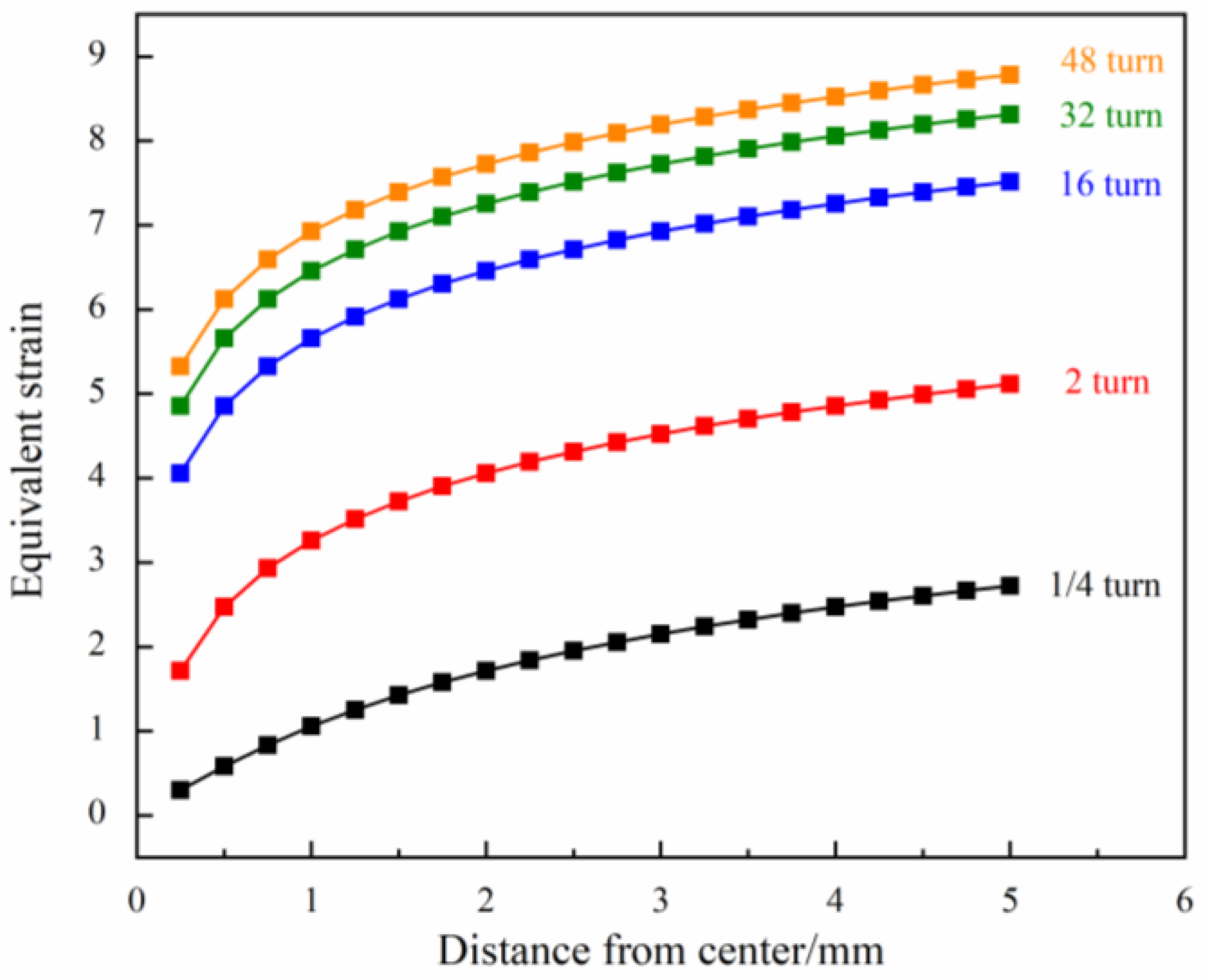
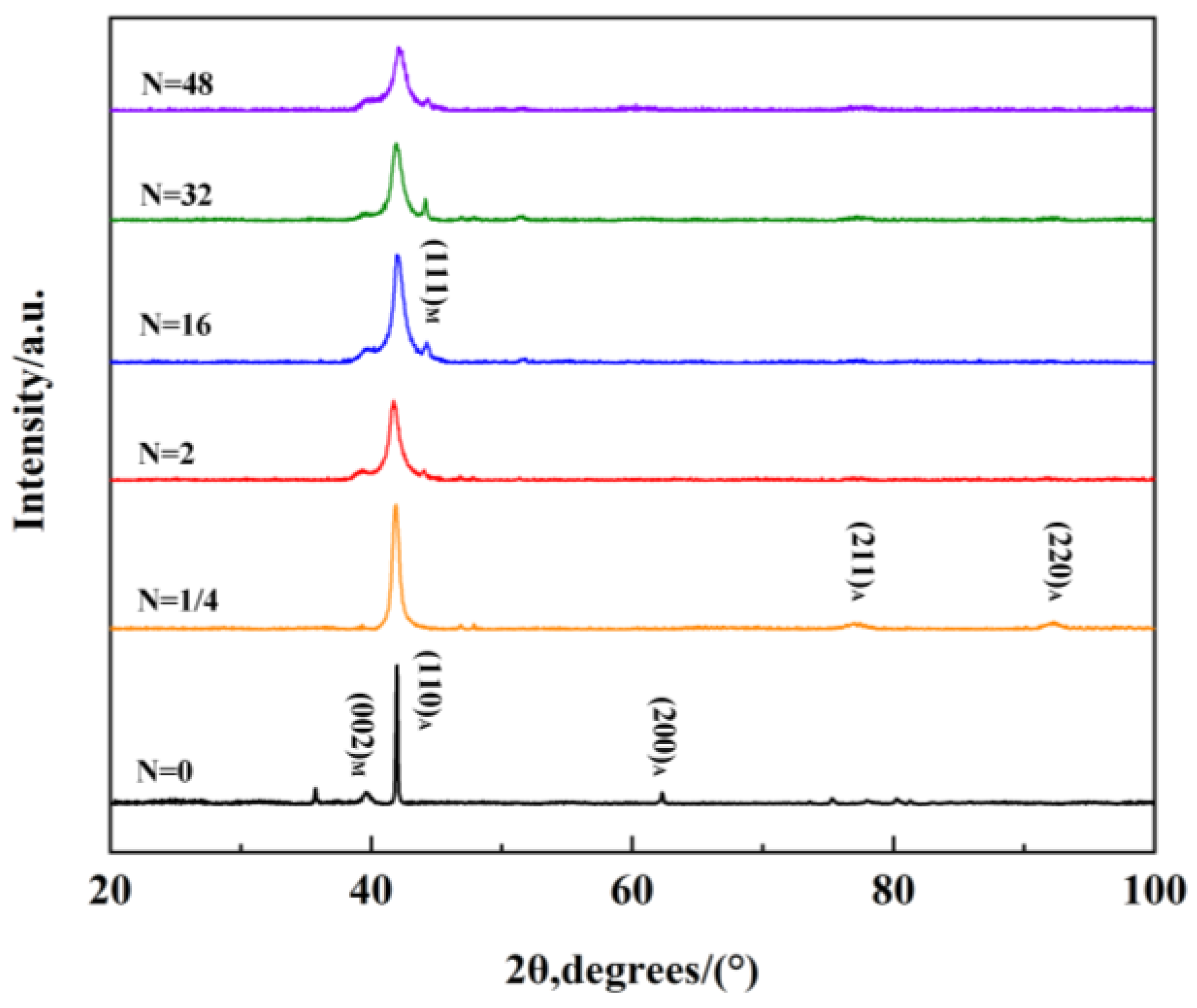
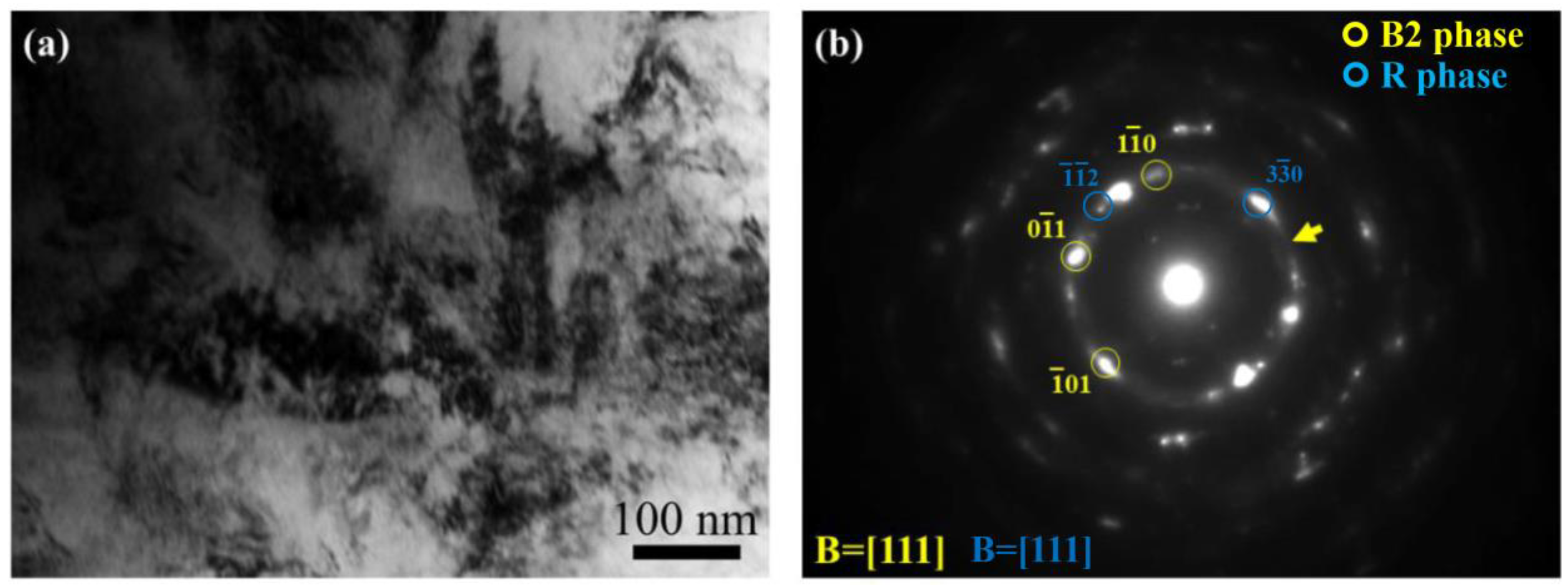
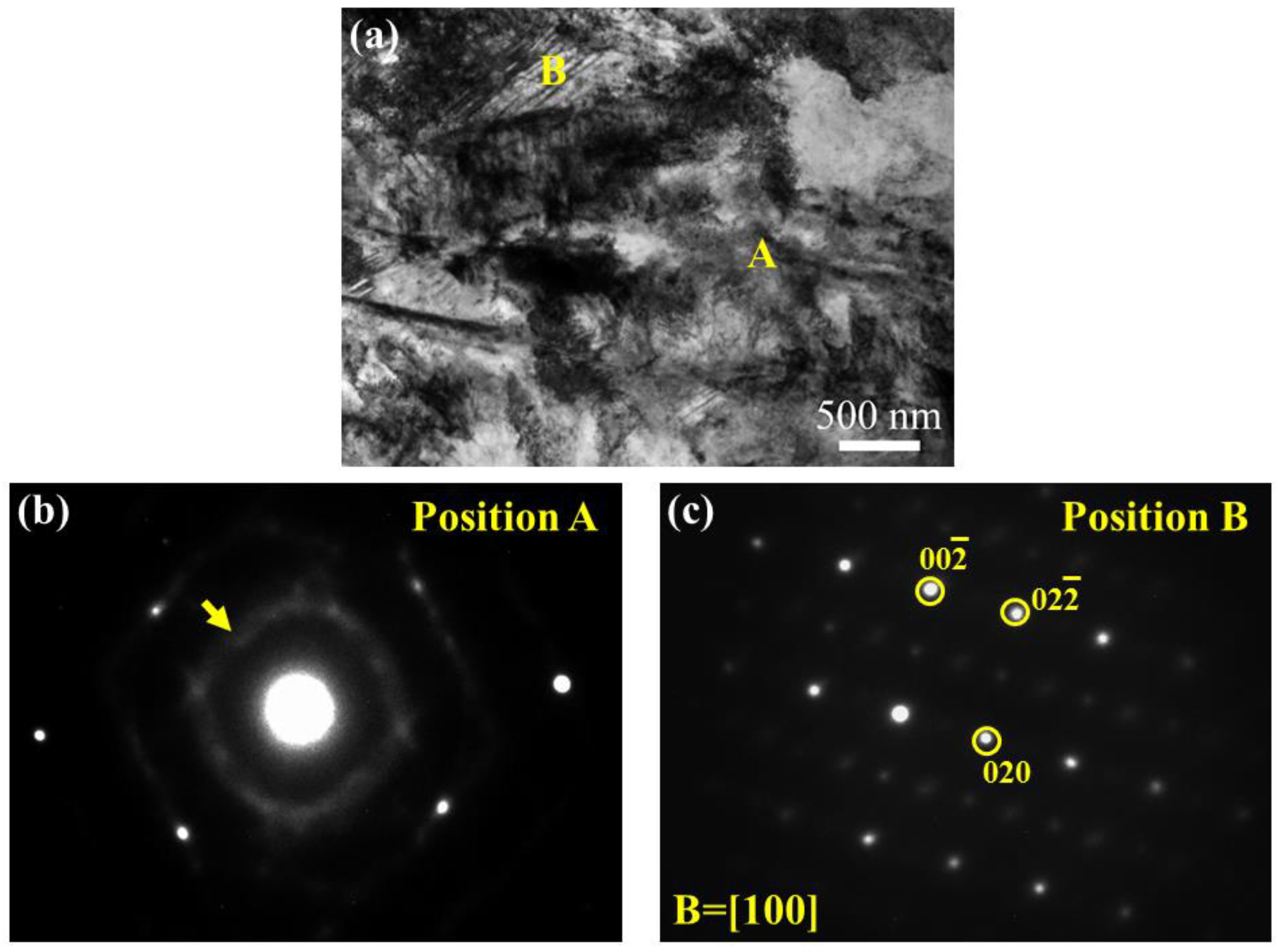
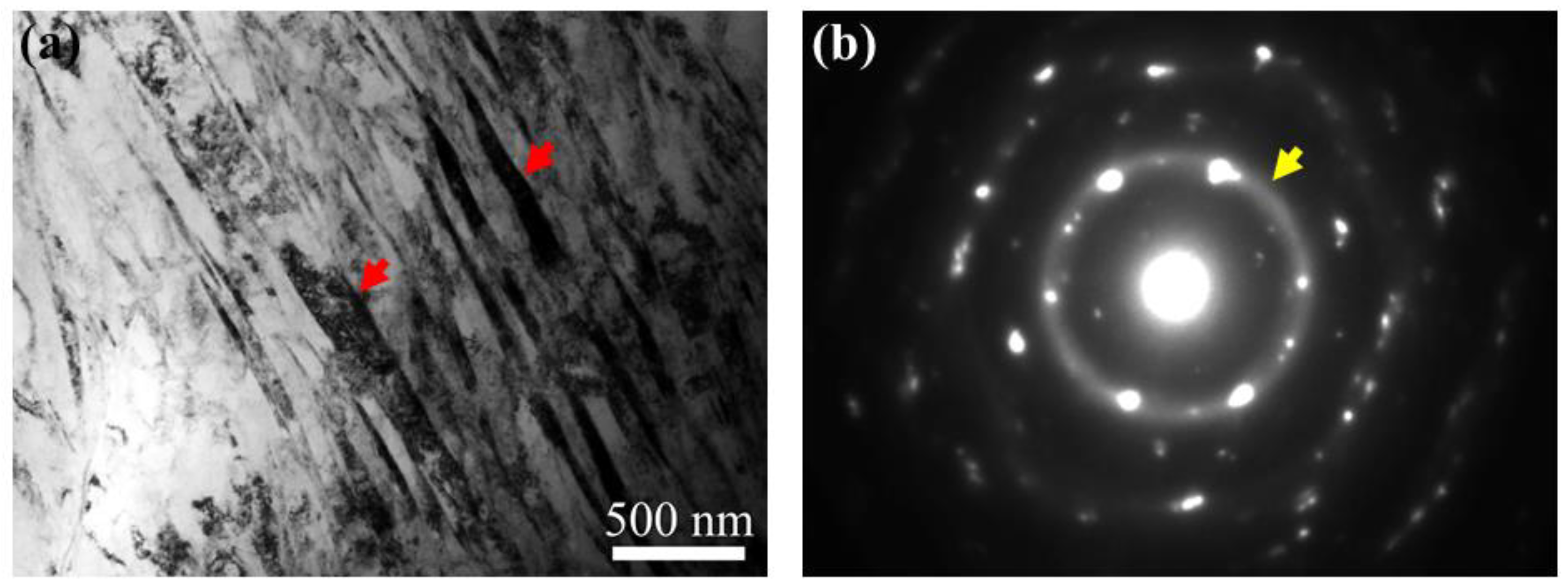
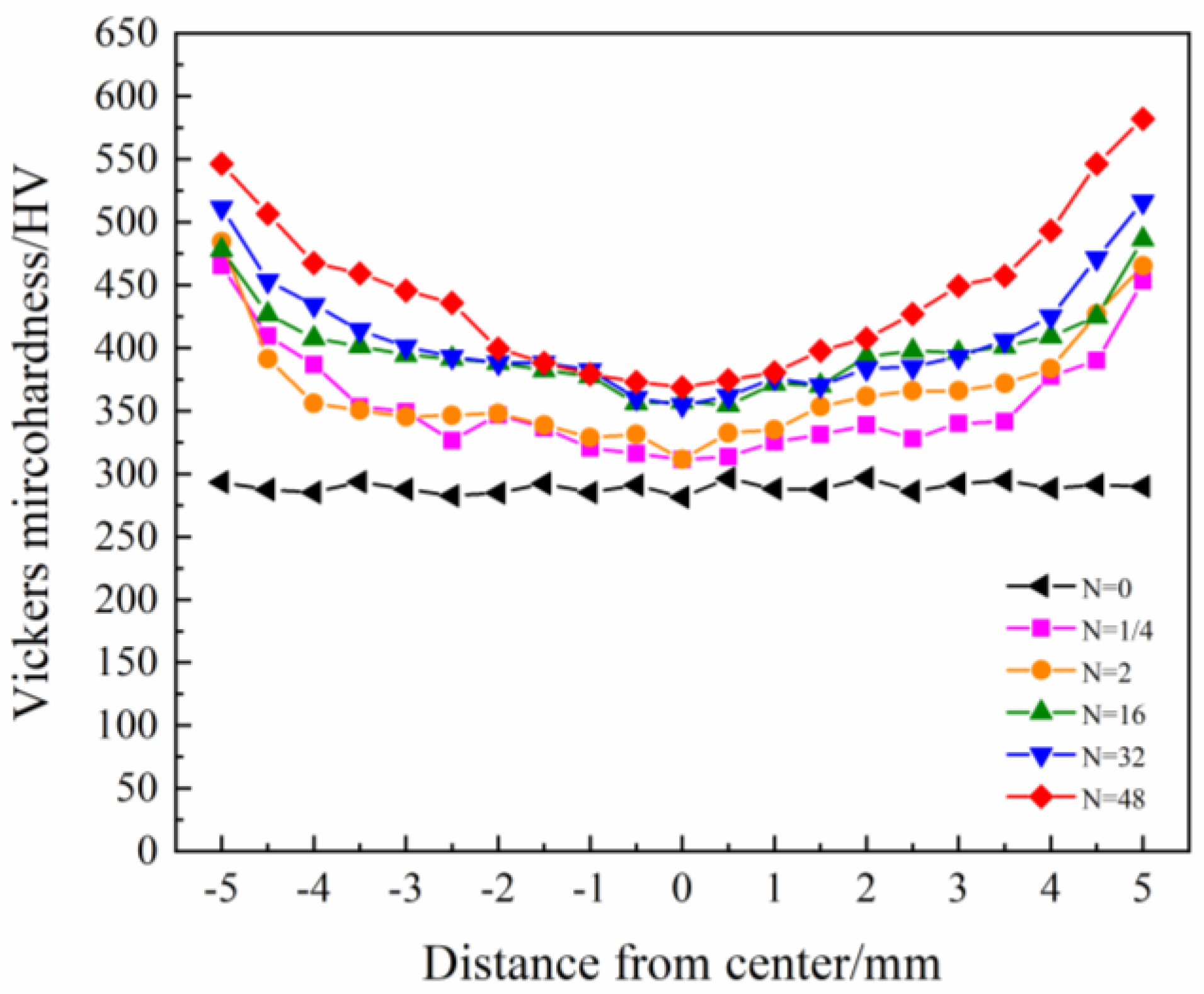
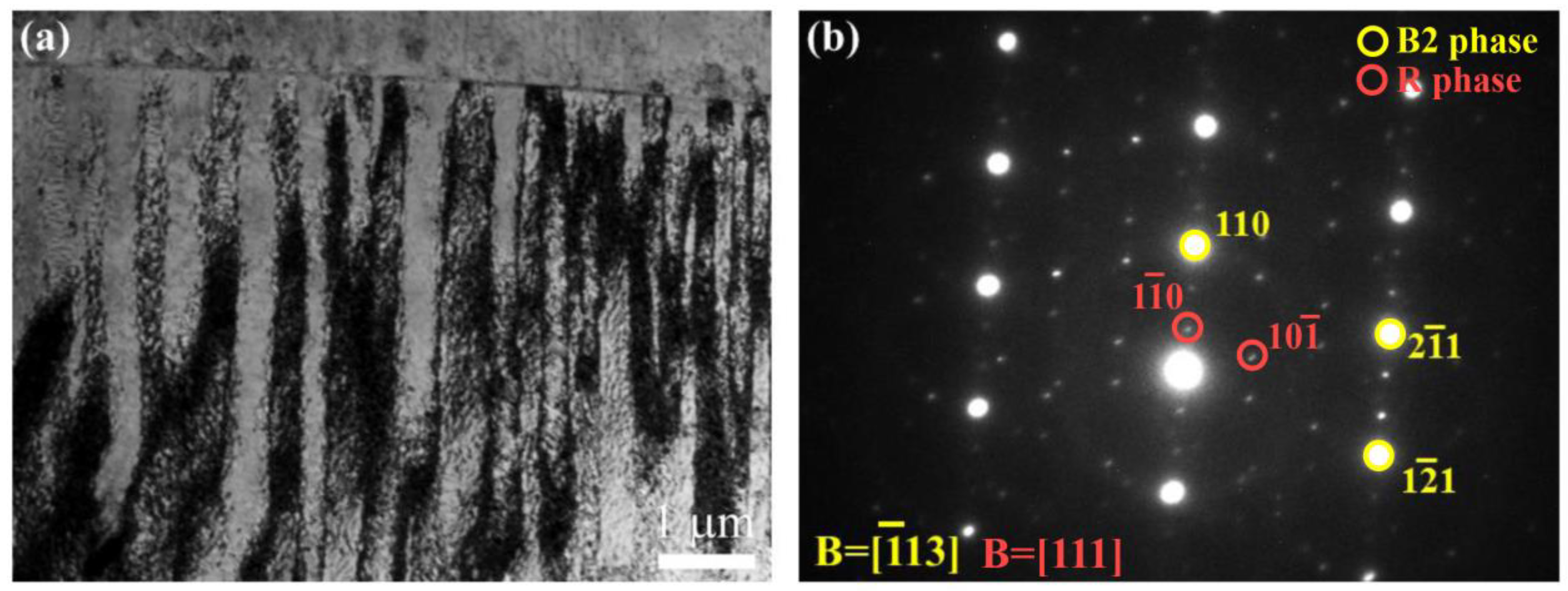
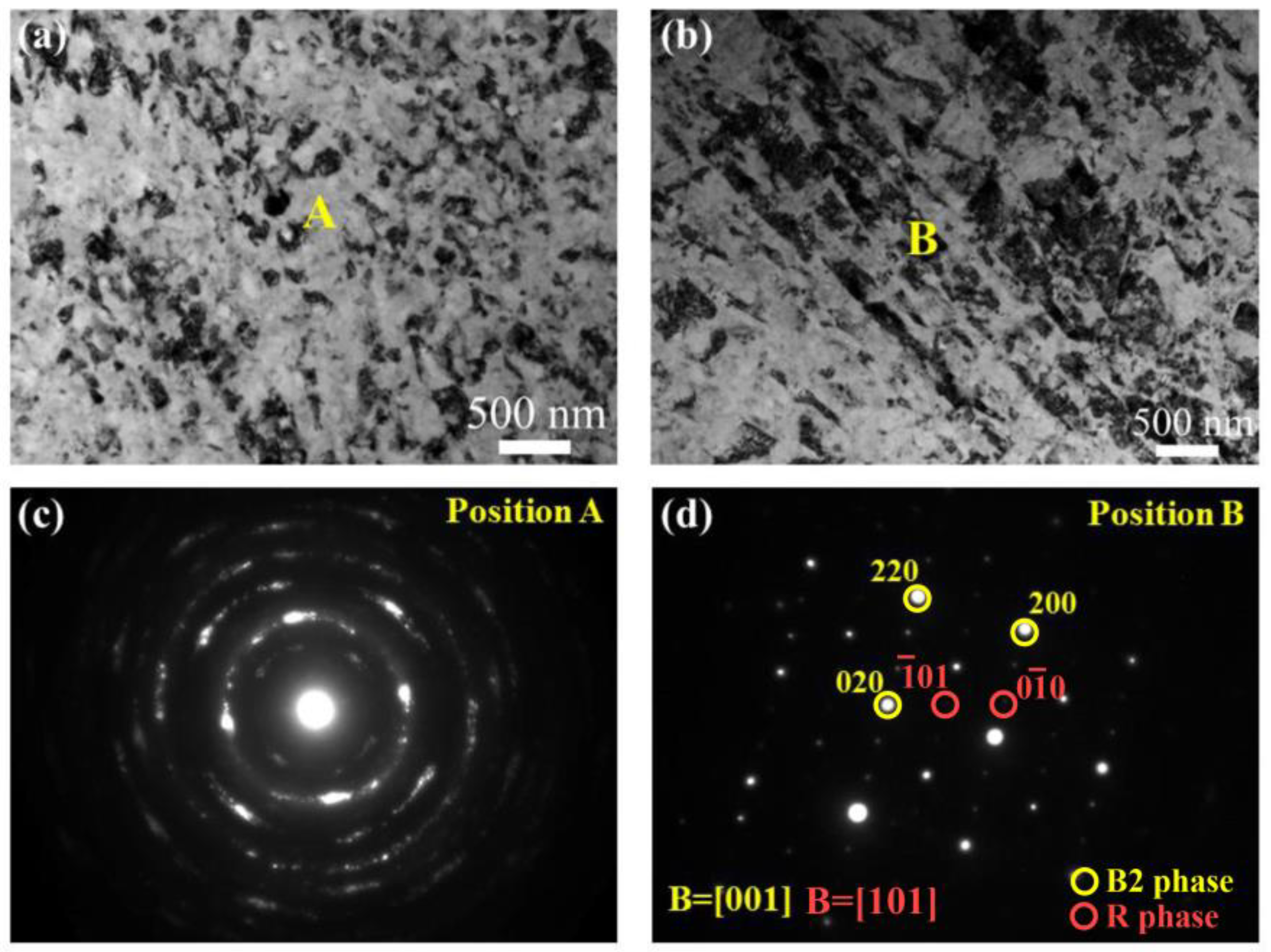

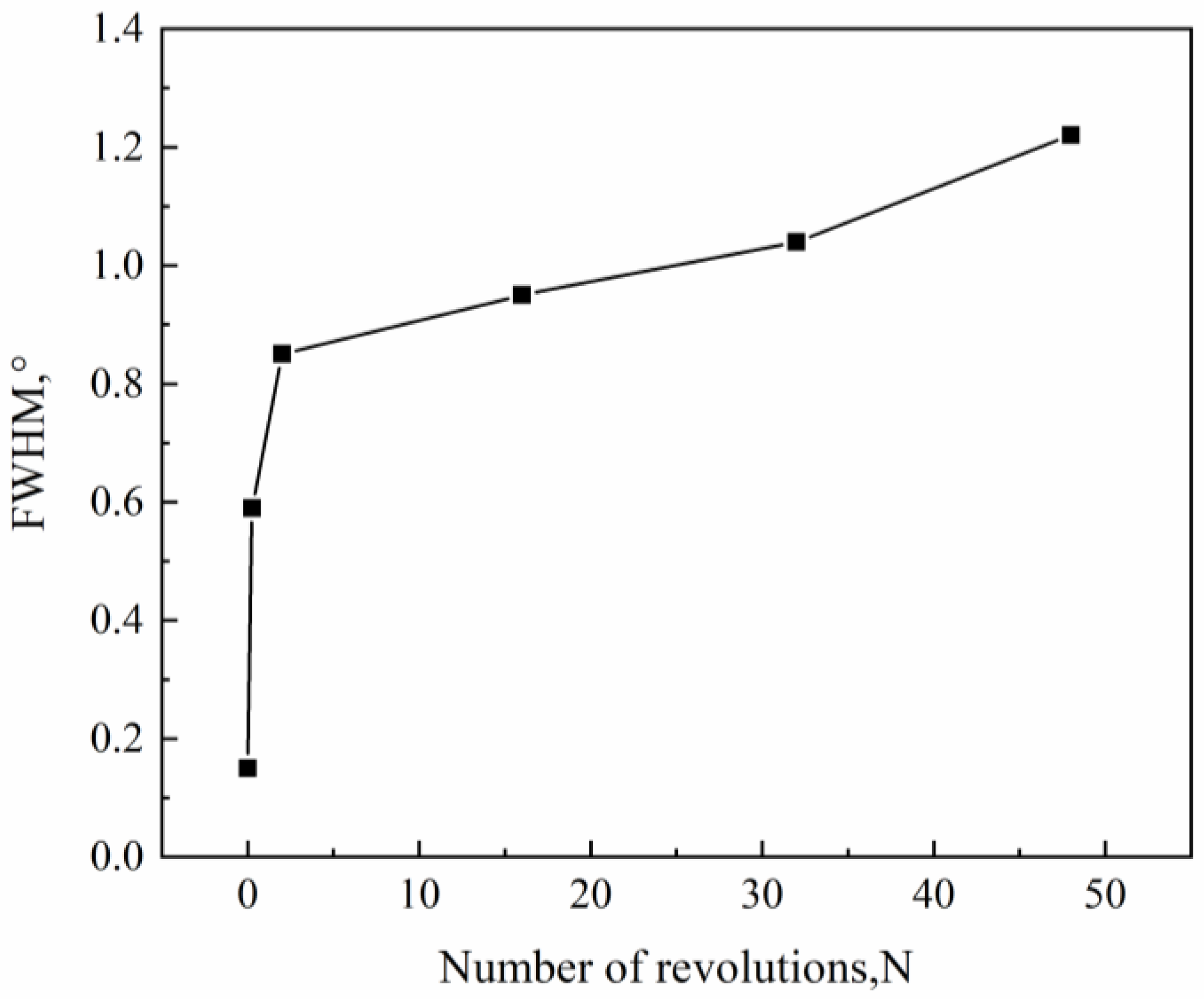
| Number of Revolutions, N | Equivalent Strain, ε (1/2 Radius) | FWHM, 2θ ° |
|---|---|---|
| 0 | 0 | 0.15 |
| 1/4 | 1.952 | 0.59 |
| 2 | 4.313 | 0.85 |
| 16 | 6.714 | 0.95 |
| 32 | 7.514 | 1.04 |
| 48 | 7.983 | 1.22 |
Disclaimer/Publisher’s Note: The statements, opinions and data contained in all publications are solely those of the individual author(s) and contributor(s) and not of MDPI and/or the editor(s). MDPI and/or the editor(s) disclaim responsibility for any injury to people or property resulting from any ideas, methods, instructions or products referred to in the content. |
© 2024 by the authors. Licensee MDPI, Basel, Switzerland. This article is an open access article distributed under the terms and conditions of the Creative Commons Attribution (CC BY) license (https://creativecommons.org/licenses/by/4.0/).
Share and Cite
Zhang, J.; Wang, S.; Hu, P.; Zhang, Y.; Ding, H.; Huang, Y. Effects of Severe Plastic Deformation and Subsequent Annealing on Microstructures of a Ni50.6Ti49.4 Shape Memory Alloy. Metals 2024, 14, 184. https://doi.org/10.3390/met14020184
Zhang J, Wang S, Hu P, Zhang Y, Ding H, Huang Y. Effects of Severe Plastic Deformation and Subsequent Annealing on Microstructures of a Ni50.6Ti49.4 Shape Memory Alloy. Metals. 2024; 14(2):184. https://doi.org/10.3390/met14020184
Chicago/Turabian StyleZhang, Jintao, Shibo Wang, Peng Hu, Yu Zhang, Hua Ding, and Yi Huang. 2024. "Effects of Severe Plastic Deformation and Subsequent Annealing on Microstructures of a Ni50.6Ti49.4 Shape Memory Alloy" Metals 14, no. 2: 184. https://doi.org/10.3390/met14020184
APA StyleZhang, J., Wang, S., Hu, P., Zhang, Y., Ding, H., & Huang, Y. (2024). Effects of Severe Plastic Deformation and Subsequent Annealing on Microstructures of a Ni50.6Ti49.4 Shape Memory Alloy. Metals, 14(2), 184. https://doi.org/10.3390/met14020184







